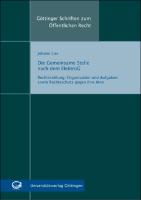Die Gemeinsame Stelle nach dem ElektroG
Rechtsstellung, Organisation und Aufgaben sowie Rechtsschutz gegen ihre Akte
Author(s)
Lier, Johann
Collection
AG UniversitätsverlageLanguage
GermanAbstract
The Electrical and Electronic Equipment Act (ElektroG) that took effect in 2005 follows an independent method as opposed to the conventional execution carried out by state authorities with regards to the legal execution. It commits the producer of electrical and electronic equipment to the establishment of a private law Clearing House (Gemeinsame Stelle) and assigns it numerous tasks to be carried out on its own responsibility. The significance of the Clearing House for the implementation of the Electrical and Electronic Equipment Act is heightened by the fact that it assumes additional sovereign tasks assigned to it within the scope of the designation. This unusual double function is applied to the task at hand and illuminates the status and organisation of Stiftung Elektro-Altgeräte-Register that is set up as Clearing House. The task furthermore examines the most important tasks in practice of producer registration and the coordination of WEEE collection, as well as the thus far little researched task of specifying the equipment types important for implementation. The work is rounded off by a chapter dedicated to the issues of legal protection against the measures of Stiftung Elektro-Altgeräte-Register, particularly in its function as designated agency.
Keywords
producer registration and the coordination of WEEE collection; Electrical and Electronic Equipment Act (ElektroG); legal protectionDOI
10.17875/gup2016-955ISBN
9783863952563, 9783863952563Publisher
Universitätsverlag GöttingenPublication date and place
2016Classification
Law


 Download
Download